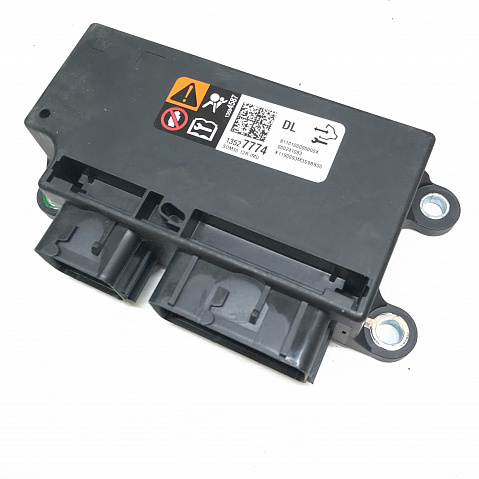An Airbag Diagnostic Module (ADM), also known as a Sensor Diagnostic Unit (SDU) or Airbag Electronic Crash unit (ECU), is a critical safety device in modern vehicles. It is responsible for detecting collisions and deploying the airbags at the right time.
The ADM is located in a central location in the vehicle, such as under the driver's or passenger seat or in the center console. It is connected to a network of sensors throughout the vehicle that detect impacts. When an impact is detected, the sensors send a signal to the ADM.
The ADM then analyzes the data from the sensors to determine the severity of the impact and whether or not to deploy the airbags. If the impact is severe enough, the ADM will send a signal to the airbags to inflate.
The ADM is a complex device that is essential for the proper operation of the airbag system. It is important to keep the ADM clean and well-maintained, and to have it inspected regularly by a qualified mechanic.
Call Us: (571) 417-5717The airbag diagnostic module (ADM) is a critical component in modern vehicle safety systems, often referred to as the "brain" of the airbag system. This module continuously monitors the status of the airbag system, ensuring that all components function correctly and are ready to deploy in the event of a collision. This detailed guide explores the functionality, benefits, types, maintenance, and considerations related to airbag diagnostic modules, emphasizing their crucial role in automotive safety.
An airbag diagnostic module is an electronic control unit (ECU) responsible for managing and monitoring the airbag system in a vehicle. It receives input from various sensors located throughout the vehicle, processes this information, and determines if and when to deploy the airbags. The ADM ensures that the airbag system is operational at all times and provides diagnostic information to alert drivers of any issues.
Monitoring and Diagnostics - The ADM continuously monitors the airbag system through various sensors that detect changes in vehicle speed, impact force, and occupant presence. It checks the status of the airbag circuits, crash sensors, seat belt pretensioners, and other related components. If any discrepancies or faults are detected, the ADM triggers a warning light on the vehicle’s dashboard to inform the driver of potential issues.
Deployment Decision - In the event of a collision, the ADM processes data from the sensors to determine the severity and nature of the impact. Based on this information, it decides whether to deploy the airbags and which airbags to deploy (e.g., front, side, curtain). This decision is made within milliseconds to provide timely protection to vehicle occupants.
Post-Deployment Analysis - After an airbag deployment, the ADM records data related to the crash event, such as the impact severity, airbag deployment times, and sensor readings. This information can be used for diagnostic purposes, accident analysis, and to ensure that the airbag system functioned correctly during the collision.

Enhanced Vehicle Safety - The primary benefit of an ADM is the enhanced safety it provides. By continuously monitoring the airbag system and ensuring it is always ready to deploy, the ADM helps protect occupants in the event of a collision.
Timely Fault Detection - The ADM's ability to detect and diagnose faults in the airbag system ensures that potential issues are identified and addressed promptly. This proactive approach helps prevent airbag failures and ensures that the system operates correctly when needed.
Comprehensive Data Recording - The ADM records valuable data during and after a collision, providing insights into the event and the airbag system's performance. This data can be crucial for accident reconstruction, insurance claims, and improving future vehicle safety designs.
Standard ADMs - Standard ADMs perform basic monitoring and diagnostic functions for the airbag system. They are typically found in most vehicles and provide reliable performance for essential safety functions.
Advanced ADMs - Advanced ADMs offer additional features, such as more sophisticated sensor integration, enhanced diagnostic capabilities, and support for newer airbag technologies (e.g., knee airbags, pedestrian airbags). These modules are often found in high-end or newer vehicle models, providing enhanced safety and functionality.
Regular System Checks - Regular inspections and system checks are essential to ensure the ADM functions correctly. Vehicle owners should pay attention to the airbag warning light on the dashboard. If the light is illuminated, it indicates a potential issue with the airbag system that needs immediate attention.
Professional Diagnostics - If any issues with the ADM are detected, it is crucial to have the system inspected and repaired by a qualified technician. Professional diagnostics can identify and resolve potential problems, ensuring the ADM and the entire airbag system are fully operational.
Software Updates - Some ADMs may require periodic software updates to improve functionality or address known issues. These updates are typically provided by the vehicle manufacturer and should be installed by a professional to ensure compatibility and optimal performance.
The Airbag Diagnostic Module is a silent guardian of vehicle safety, ensuring that airbags deploy with precision and effectiveness when accidents occur. Vehicle owners should prioritize regular maintenance and prompt inspections to ensure that this critical component functions optimally, providing the highest level of protection to occupants during accidents.